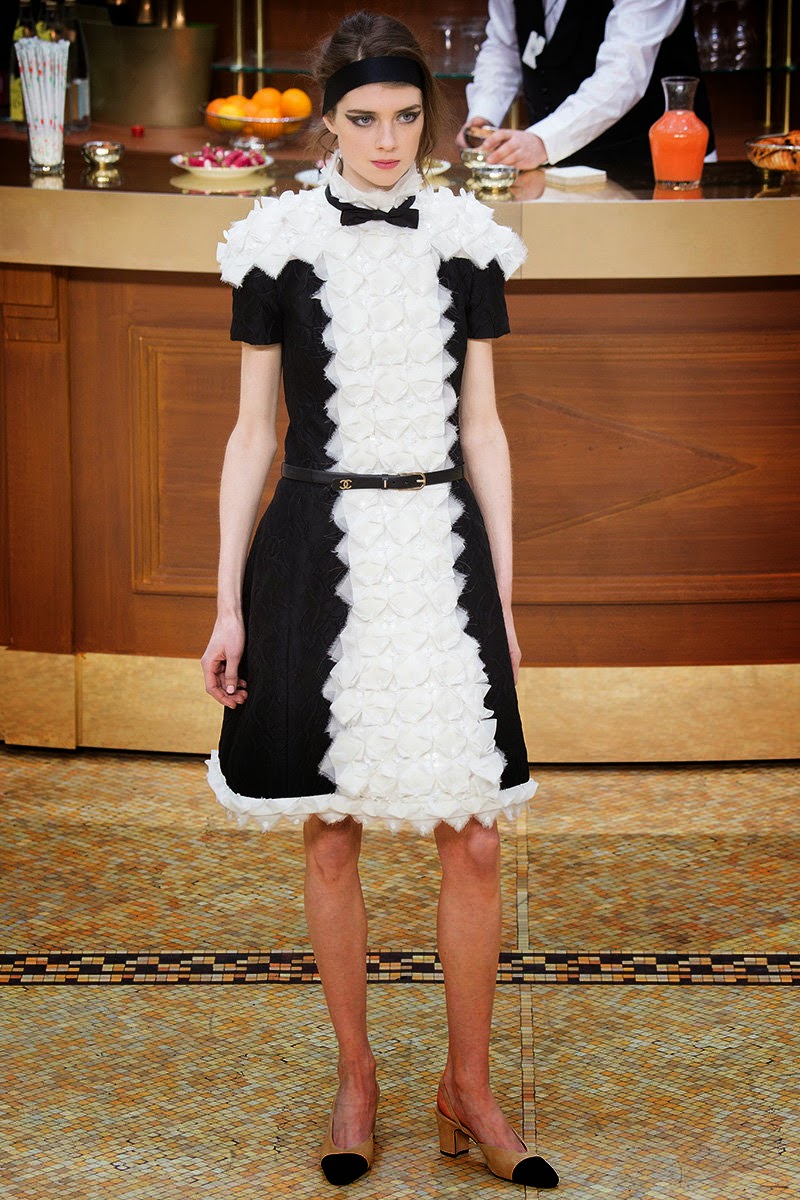Karl Lagerfeld set his Chanel collection in that most quintessential of Parisian settings: a bistro and café that he playfully named 'Brasserie Gabrielle', complete with waiters serving croissants and coffee at the bar to the fashion show’s guests, and classic flower arrangements of palm fronds and beetroot red flowers.
“Cuisine traditionnelle,” he joked during fittings in his frenetic studio on the Rue Cambon, the day before the show. “More French you cannot get. It’s a French collection,” Karl added, “because I’m against French-bashing.”
The café society influence seeped playfully into the clothes and accessories with skirts that wrap and then tie with attached tapes, resembling the old-fashioned aprons still worn by some French waiters. There were even some that looked as though they had been created from folded-up café napkins. “It makes a long skirt not dowdy, and you can walk and sit down in it,” Karl explained as he gave one apron-wrapped girl a clutch with ceramic bistro plates attached (for high-fashion bus-girl realness). The classic Chanel camellia boutonniere, meanwhile, was reimagined as a doll-size place setting of stacked plates.
Karl dubbed his look “the New Bourgeoisie,” sending out suits in the classic Linton and Harris tweeds that Coco Chanel herself used and that were fashioned into ironic frumpy knee-length skirts (even with matching umbrellas), or reinvented into the trompe l’oeil “suit-dress” in the bell-skirted silhouette that Karl introduced at his spring couture show. Those suit-dresses also appeared in knit, the intarsia patterns suggesting a cardigan jacket and an A-line skirt; “More Chanel you die, no?” said Karl, “but in fact she never did it!” Sensational too were a brace of slinky knitted sweaterdresses made long enough to train on the floor and the baby doll dresses in swinging black chiffon, the translucency revealing the beige “form” dress beneath. Karl even revived the classic two-tone pump that Chanel herself introduced in the fifties and that has been an icon of conservative seizième taste ever since. “I never used this shoe,” said Karl, “and now it’s the only shoe. I’m tired of platforms, of stilettos.” He tweaked it, of course, giving it a sensible clunky heel (more irony here) and curving its slingback asymmetrically across the foot to give an elegant little twist to the classicism.
Meanwhile, the decorated parka (staple of those elegant BCBG Parisiennes) more or less replaced the coat surely an instant must-have item for any self-respecting Chanelite. Taking the idea of the three-dimensional embroideries in the January couture collection that suggested folded paper lanterns, he used more origami-pleated treatments to embellish the plastrons, or punctuated the quilting with dainty little bows, or bedazzled metallic tweeds with fanciful crystal embroideries. “These are clothes for lunch and dinner,” said Karl, having the last word, as ever. “The ‘ladies’ are gone . . . but the meals stay.” I’ll drink to that.
Selections by ANDREA JANKE Finest Accessories
Photo Credit/Source: The House of CHANEL
Photos: Kevin Tachman (still), Kim Weston Arnold (runway)
More To Love ...
Yesterday, I had the great pleasure to expect the "Brasserie Gabrielle" collection at Grand Palais, Paris, in a fabulous decor inspired by a Parisian brasserie, set for the Fall/Winter 2015/16 Ready‑to‑Wear show. Within this first post, I'd like to present you my personal Instagram-story of this gorgeous setting - enjoy!
Coco Chanel often attended the Parisian brasseries with her artist friends. Following theatrical performances, Gabrielle surrounded by Igor Stravinsky, dancer and choreographer Serge Lifar, or Salvador Dalí, would take her place in these enlightened restaurants where elegance, great minds and gastronomy created a harmonious blend.
'Brasserie Gabrielle' by CHANEL via Instagram by @andreajankeofficial
Tweet






































































































No comments:
Post a Comment